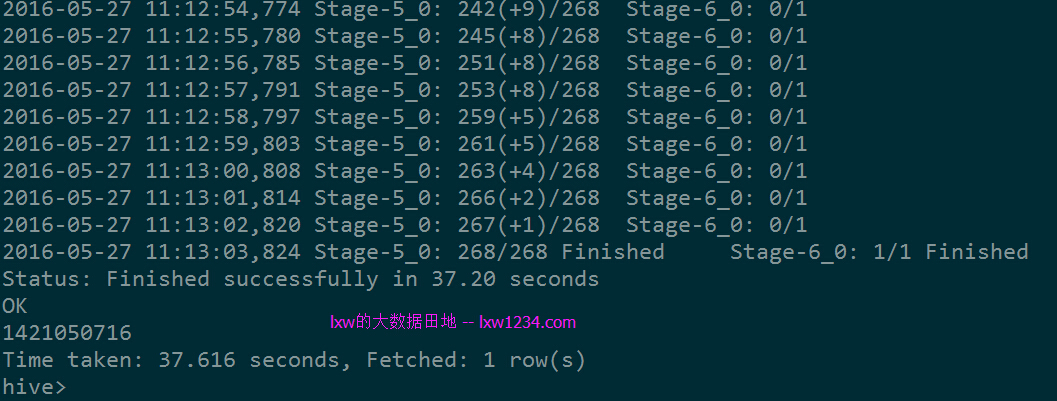Hive从1.1之后,支持使用Spark作为执行引擎,配置使用Spark On Yarn作为Hive的执行引擎,首先需要注意以下两个问题:
Hive的版本和Spark的版本要匹配;
具体来说,你使用的Hive版本编译时候用的哪个版本的Spark,那么就需要使用相同版本的Spark,可以在Hive的pom.xml中查看spark.version来确定;
Hive root pom.xml’s <spark.version> defines what version of Spark it was built/tested with.
Spark使用的jar包,必须是没有集成Hive的;
也就是说,编译时候没有指定-Phive.
一般官方提供的编译好的Spark下载,都是集成了Hive的,因此这个需要另外编译。
Note that you must have a version of Spark which does not include the Hive jars. Meaning one which was not built with the Hive profile.
如果不注意版本问题,则会遇到各种错误,比如:
- Caused by: java.lang.NoClassDefFoundError: org/apache/hive/spark/client/Job
- Caused by: java.lang.ClassNotFoundException: org.apache.hive.spark.client.Job
我这里使用的环境信息如下:
hadoop-2.3.0-cdh5.0.0
apache-hive-2.0.0-bin
spark-1.5.0-bin-hadoop2.3
其中,Spark使用了另外编译的spark-assembly-1.5.0-hadoop2.3.0.jar。编译很简单,下载spark-1.5.0的源码,使用命令:
mvn -Pyarn -Phadoop-2.3 -Dhadoop.version=2.3.0-cdh5.0.0 -DskipTests -Dscala-2.10 clean package
首先在hive-site.xml中添加spark.home:
<property>
<name>spark.home</name>
<value>/usr/local/spark/spark-1.5.0-bin-hadoop2.3</value>
</property>
同时也配置了环境变量
export SPARK_HOME=/usr/local/spark/spark-1.5.0-bin-hadoop2.3
这两块应该只需要配置一处即可。
进入hive-cli命令行,使用set的方式设置以下参数:
- set spark.master=yarn-cluster; //默认即为yarn-cluster模式,该参数可以不配置
- set hive.execution.engine=spark;
- set spark.eventLog.enabled=true;
- set spark.eventLog.dir=hdfs://cdh5/tmp/sparkeventlog;
- set spark.executor.memory=1g;
- set spark.executor.instances=50; //executor数量,默认貌似只有2个
- set spark.driver.memory=1g;
- set spark.serializer=org.apache.spark.serializer.KryoSerializer;
当然,这些参数也可以配置在hive-site.xml中。
接下来就可以执行HQL查询试试了:


可以看到,已经使用Spark作为执行引擎了。

在Yarn的WEB页面上也看到了对应的Application。
在进入hive-cli命令行,第一次执行查询之后,Hive向Yarn申请Container资源,即参数spark.executor.instances指定的数量,另外加一个Driver使用的Container。该Application便会一直运行,直到退出hive-cli,该Application便会成功结束,期间占用的集群资源不会自动释放和回收。如果在hive-cli中修改和executor相关的参数,再次执行查询时候,Hive会结束上一次在Yarn上运行的Application,重新申请资源提交运行。
----------------------------------------------------------------------------------------------------------
Fair Scheduler配置示例
以上面图中所示的业务场景为例。
yarn-site.xml中的配置:
<!– scheduler start –>
<property>
<name>yarn.resourcemanager.scheduler.class</name>
<value>org.apache.hadoop.yarn.server.resourcemanager.scheduler.fair.FairScheduler</value>
</property>
<property>
<name>yarn.scheduler.fair.allocation.file</name>
<value>/etc/hadoop/conf/fair-scheduler.xml</value>
</property>
<property>
<name>yarn.scheduler.fair.preemption</name>
<value>true</value>
</property>
<property>
<name>yarn.scheduler.fair.user-as-default-queue</name>
<value>true</value>
<description>default is True</description>
</property>
<property>
<name>yarn.scheduler.fair.allow-undeclared-pools</name>
<value>false</value>
<description>default is True</description>
</property>
<!– scheduler end –>
yarn.resourcemanager.scheduler.class
配置Yarn使用的调度器插件类名;
Fair Scheduler对应的是:
org.apache.hadoop.yarn.server.resourcemanager.scheduler.fair.FairScheduler
yarn.scheduler.fair.allocation.file
配置资源池以及其属性配额的XML文件路径(本地路径);
yarn.scheduler.fair.preemption
开启资源抢占。
yarn.scheduler.fair.user-as-default-queue
设置成true,当任务中未指定资源池的时候,将以用户名作为资源池名。这个配置就实现了根据用户名自动分配资源池。
yarn.scheduler.fair.allow-undeclared-pools
是否允许创建未定义的资源池。
如果设置成true,yarn将会自动创建任务中指定的未定义过的资源池。设置成false之后,任务中指定的未定义的资源池将无效,该任务会被分配到default资源池中。
fair-scheduler.xml中的配置:
<?xml version=”1.0″?>
<allocations>
<!– users max running apps –>
<userMaxAppsDefault>30</userMaxAppsDefault>
<!– queues –>
<queue name=”root”>
<minResources>51200mb,50vcores</minResources>
<maxResources>102400mb,100vcores</maxResources>
<maxRunningApps>100</maxRunningApps>
<weight>1.0</weight>
<schedulingMode>fair</schedulingMode>
<aclSubmitApps> </aclSubmitApps>
<aclAdministerApps> </aclAdministerApps>
<queue name=”default”>
<minResources>10240mb,10vcores</minResources>
<maxResources>30720mb,30vcores</maxResources>
<maxRunningApps>100</maxRunningApps>
<schedulingMode>fair</schedulingMode>
<weight>1.0</weight>
<aclSubmitApps>*</aclSubmitApps>
</queue>
<queue name=”businessA”>
<minResources>5120mb,5vcores</minResources>
<maxResources>20480mb,20vcores</maxResources>
<maxRunningApps>100</maxRunningApps>
<schedulingMode>fair</schedulingMode>
<weight>2.0</weight>
<aclSubmitApps>businessA,szb group_businessA,group_szb</aclSubmitApps>
<aclAdministerApps>businessA,hadoop group_businessA,supergroup</aclAdministerApps>
</queue>
<queue name=”businessB”>
<minResources>5120mb,5vcores</minResources>
<maxResources>20480mb,20vcores</maxResources>
<maxRunningApps>100</maxRunningApps>
<schedulingMode>fair</schedulingMode>
<weight>1</weight>
<aclSubmitApps>businessB group_businessA</aclSubmitApps>
<aclAdministerApps>businessA,hadoop group_businessA,supergroup</aclAdministerApps>
</queue>
<queue name=”businessC”>
<minResources>5120mb,5vcores</minResources>
<maxResources>20480mb,20vcores</maxResources>
<maxRunningApps>100</maxRunningApps>
<schedulingMode>fair</schedulingMode>
<weight>1.5</weight>
<aclSubmitApps>businessC group_businessC</aclSubmitApps>
<aclAdministerApps>businessC,hadoop group_businessC,supergroup</aclAdministerApps>
</queue>
</queue>
</allocations>
minResources
最小资源
maxResources
最大资源
maxRunningApps
最大同时运行application数量
weight
资源池权重
aclSubmitApps
允许提交任务的用户名和组;
格式为: 用户名 用户组
当有多个用户时候,格式为:用户名1,用户名2 用户名1所属组,用户名2所属组
aclAdministerApps
允许管理任务的用户名和组;
格式同上。
根据用户组分配资源池
假设在生产环境Yarn中,总共有四类用户需要使用集群,开发用户、测试用户、业务1用户、业务2用户。为了使其提交的任务不受影响,我们在Yarn上规划配置了五个资源池,分别为 dev_group(开发用户组资源池)、test_group(测试用户组资源池)、business1_group(业务1用户组资源池)、business2_group(业务2用户组资源池)、default(只分配了极少资源)。并根据实际业务情况,为每个资源池分配了相应的资源及优先级等。
ResourceManager上fair-scheduler.xml配置如下:
<?xml version="1.0"?>
<allocations>
<!-- users max running apps -->
<userMaxAppsDefault>30</userMaxAppsDefault>
<queue name="root">
<aclSubmitApps> </aclSubmitApps>
<aclAdministerApps> </aclAdministerApps>
<queue name="default">
<minResources>2000mb,1vcores</minResources>
<maxResources>10000mb,1vcores</maxResources>
<maxRunningApps>1</maxRunningApps>
<schedulingMode>fair</schedulingMode>
<weight>0.5</weight>
<aclSubmitApps>*</aclSubmitApps>
</queue>
<queue name="dev_group">
<minResources>200000mb,33vcores</minResources>
<maxResources>300000mb,90vcores</maxResources>
<maxRunningApps>150</maxRunningApps>
<schedulingMode>fair</schedulingMode>
<weight>2.5</weight>
<aclSubmitApps> dev_group</aclSubmitApps>
<aclAdministerApps> hadoop,dev_group</aclAdministerApps>
</queue>
<queue name="test_group">
<minResources>70000mb,20vcores</minResources>
<maxResources>95000mb,25vcores</maxResources>
<maxRunningApps>60</maxRunningApps>
<schedulingMode>fair</schedulingMode>
<weight>1</weight>
<aclSubmitApps> test_group</aclSubmitApps>
<aclAdministerApps> hadoop,test_group</aclAdministerApps>
</queue>
<queue name="business1_group">
<minResources>75000mb,15vcores</minResources>
<maxResources>100000mb,20vcores</maxResources>
<maxRunningApps>80</maxRunningApps>
<schedulingMode>fair</schedulingMode>
<weight>1</weight>
<aclSubmitApps> business1_group</aclSubmitApps>
<aclAdministerApps> hadoop,business1_group</aclAdministerApps>
</queue>
<queue name="business2_group">
<minResources>75000mb,15vcores</minResources>
<maxResources>102400mb,20vcores</maxResources>
<maxRunningApps>80</maxRunningApps>
<schedulingMode>fair</schedulingMode>
<weight>1</weight>
<aclSubmitApps> business2_group</aclSubmitApps>
<aclAdministerApps> hadoop,business2_group</aclAdministerApps>
</queue>
</queue>
<queuePlacementPolicy>
<rule name="primaryGroup" create="false" />
<rule name="secondaryGroupExistingQueue" create="false" />
<rule name="default" />
</queuePlacementPolicy>
</allocations>
这样,每个用户组下的用户提交任务时候,会到相应的资源池中,而不影响其他业务。
需要注意的是,所有客户端提交任务的用户和用户组的对应关系,需要维护在ResourceManager上,ResourceManager在分配资源池时候,是从ResourceManager上读取用户和用户组的对应关系的,否则就会被分配到default资源池。在日志中出现”UserGroupInformation: No groups available for user”类似的警告。而客户端机器上的用户对应的用户组无关紧要。
每次在ResourceManager上新增用户或者调整资源池配额后,需要执行下面的命令刷新使其生效:
yarn rmadmin -refreshQueues
yarn rmadmin -refreshUserToGroupsMappings
-----------------------------------------------------------------------------------------------------------------------------------------





















 3085
3085











 被折叠的 条评论
为什么被折叠?
被折叠的 条评论
为什么被折叠?








